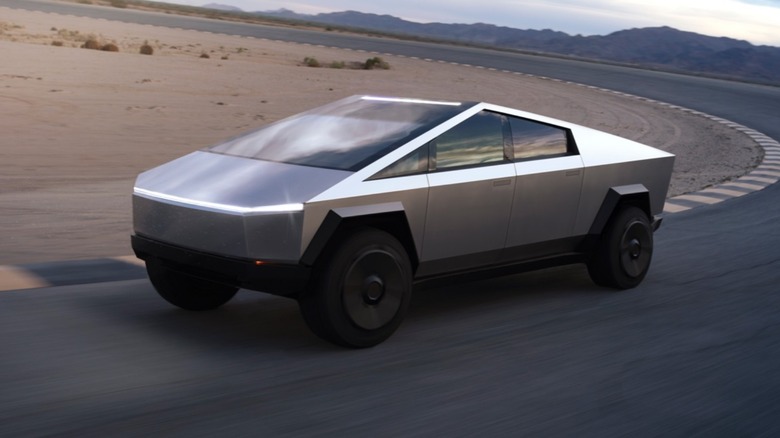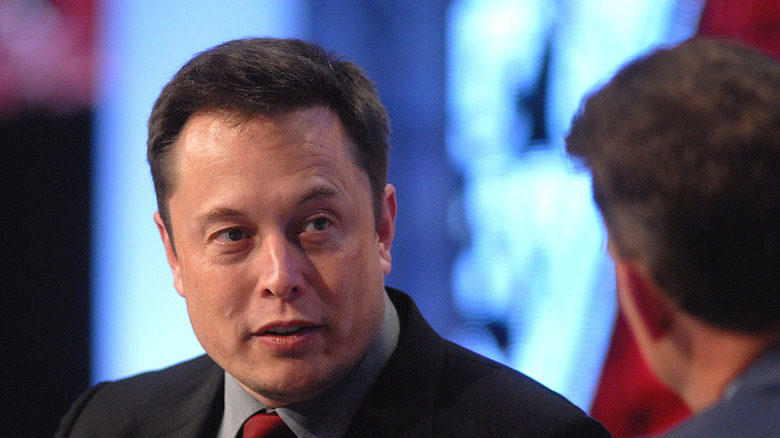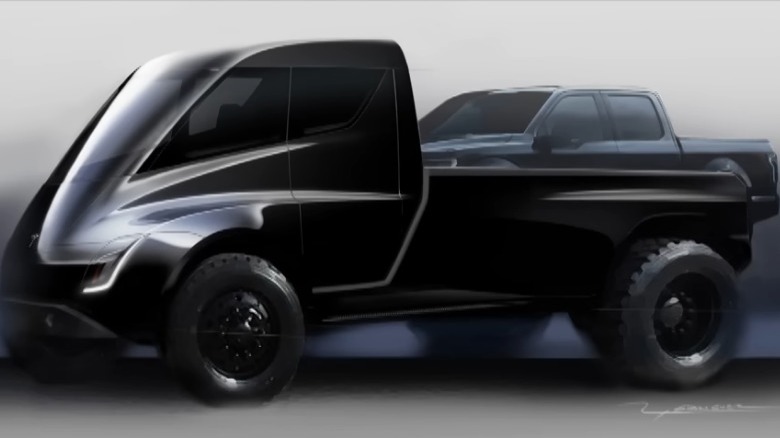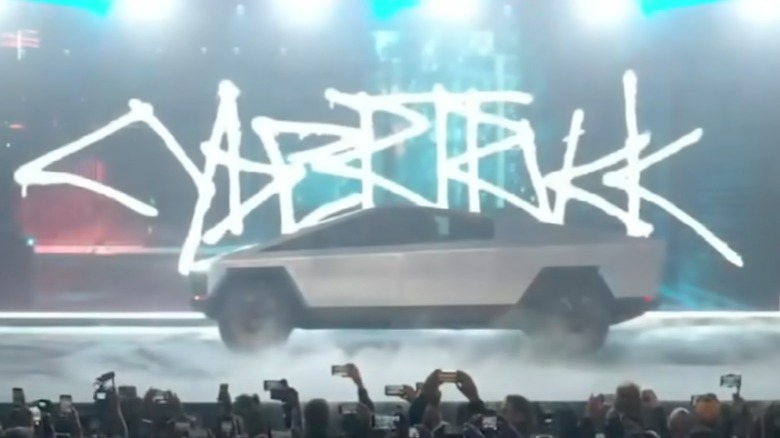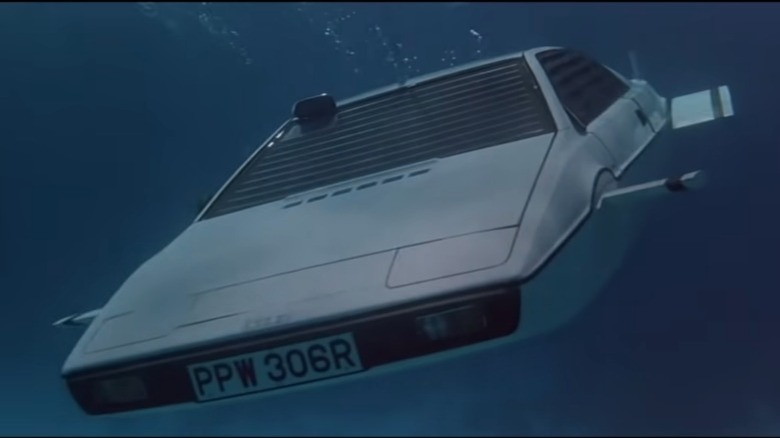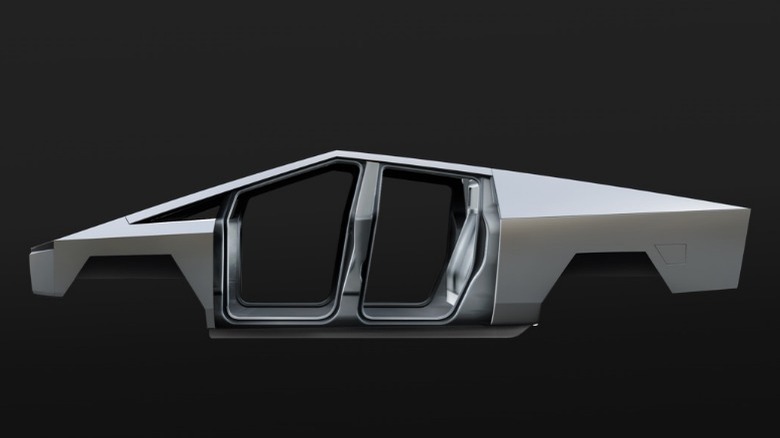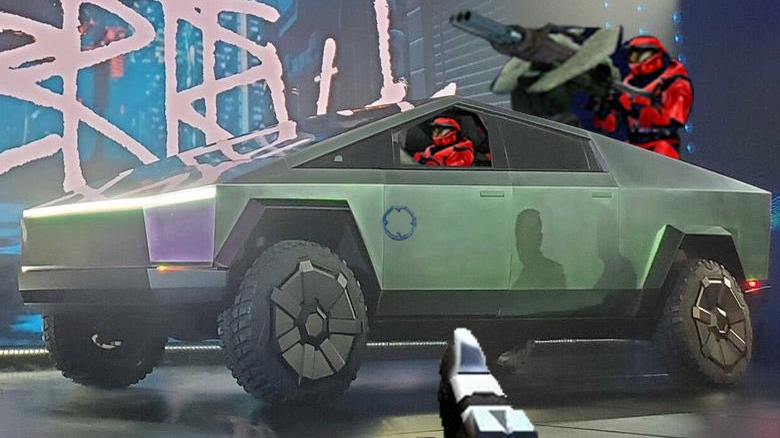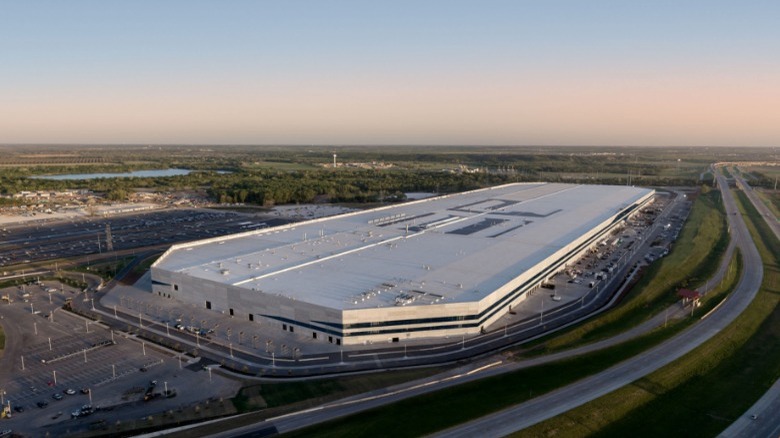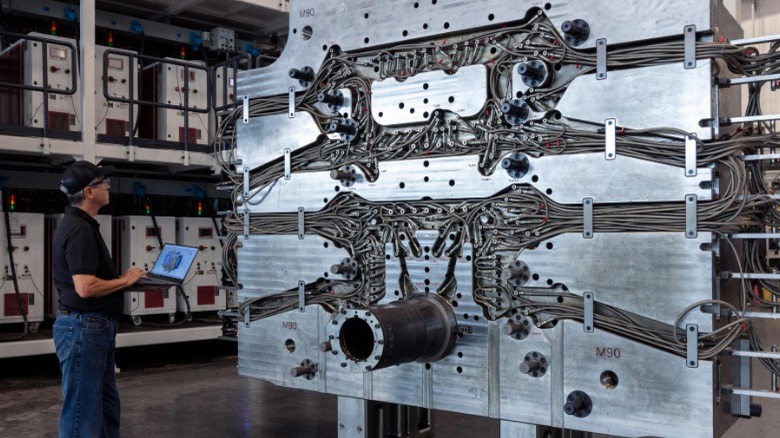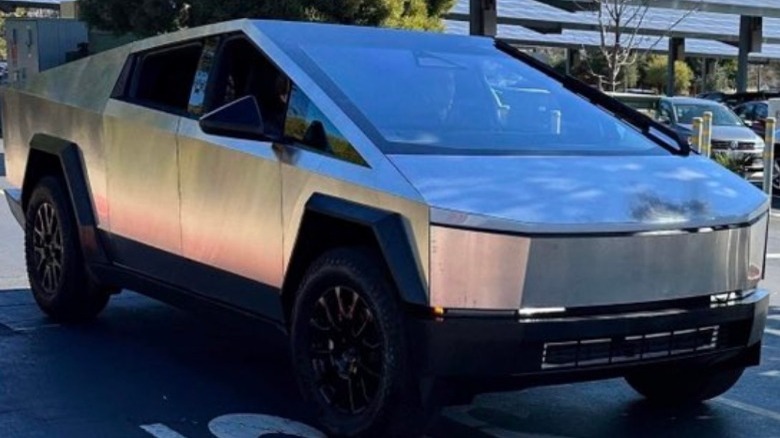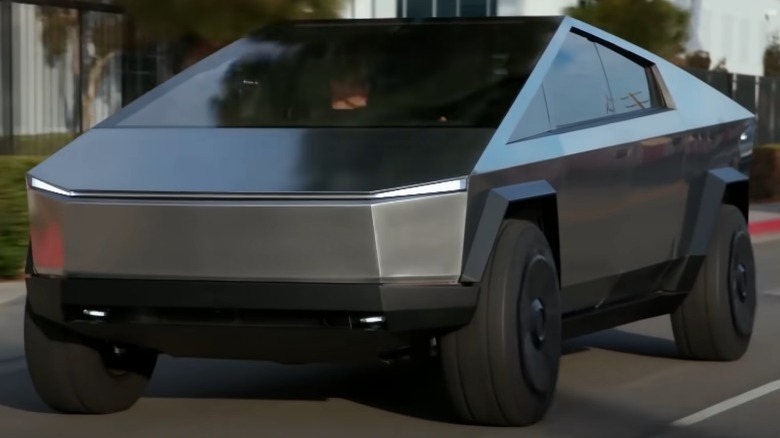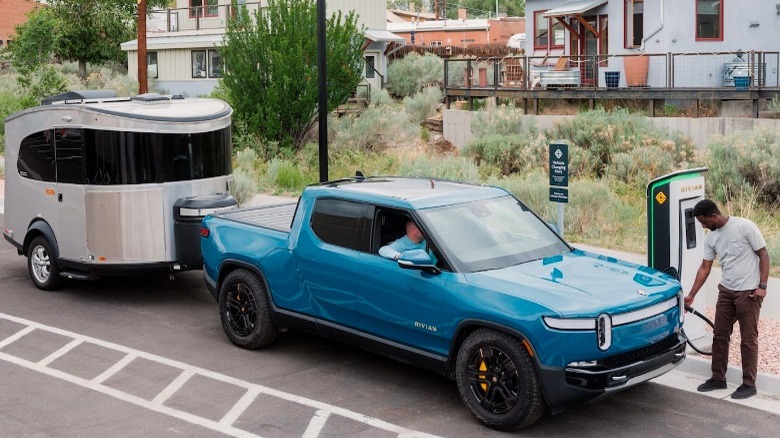The Tesla Cybertruck's Long And Complicated History Explained
Elon Musk's Tesla cars are quite the electrifying vehicles. Because of their exclusively fuel-less designs, they are all silent and emission-free. Plus, their handles sit flush against door surfaces until you need them, which is deliciously sci-fi. Like many other vehicle manufacturers, Tesla offers more than just cars. The company also produces trucks, or at least it soon will. Probably.
In 2019, Musk gave car enthusiasts their first taste of the Tesla Cybertruck. This reveal feels like it was released both yesterday and an eternity ago, but since then, nothing. Where has the time gone, and more importantly, where has our promised polygonal pickup gone? That is a story and a half, as is the vehicle's history since it has been in development for much of the Tesla company's life.
Here are all the cliff notes on Tesla Cybertruck's development.
Before production comes the idea
Most audiences only became aware of the Cybertruck when Elon Musk officially unveiled it to the world. However, the concept has been brewing in his mind far longer than many car enthusiasts realize.
Musk started toying around with the idea of a Tesla pickup truck as far back as 2012. At least, he started talking about it in 2012. He originally envisioned a "Tesla supertruck with crazy torque, dynamic air suspension, and corners like it's on rails." During an interview with CNN in 2014, Musk said the Tesla pickup would be the equivalent of a Ford F-150, and he estimated it would be available in 4-5 years. However, Musk's plans for the Tesla truck didn't end with just the truck.
In 2016, Musk outlined his dream of a more sustainable factory that could accept raw materials in one end and pop vehicles out the other. In his own words, he wanted the plant to become a product as much as its manufactured goods. To that end, Musk opened the Giga Texas factory, located near Austin, which also now serves double duty as Tesla HQ. In the automotive world, it's inefficient to devote a factory, no matter how self-contained, to one product, so Giga Texas also currently produces Tesla Model Y cars. Fingers crossed Cybertrucks will accompany Model Ys out the Giga Texas' oversized doors in the near future.
The buildup to the reveal
Before 2017, Elon Musk only toyed around with the dream of an electric pickup truck. He mostly conjectured it would be a cool idea up until he said his company was actually developing one.
Musk officially teased what would become the Cybertruck in 2017 during the official Tesla Semi & Roaster reveal. However, the concept on display was very different from what we would eventually associate with the Cybertruck. For starters, Musk claimed it would be "a pickup truck that can carry a pickup truck," yet drivers wouldn't need a special license. According to Musk, the vehicle would handle like any other Tesla, despite its size. And in 2018, he stated the prototype would be ready for a public unveiling in 2019.
Rumors started swirling after Musk's Twitter teaser tickled imaginations. Images of what fans either hoped or claimed the vehicle would look like popped up around the internet, and all of them were equally wrong. Musk stated the truck would resemble a futuristic "armored personnel carrier" more than anything anyone had imagined. Tesla aficionados also made conjectures about the truck's name. The "Model B" was a popular hypothesis since it kept in line with Tesla's naming convention, but Musk kept calling it the Cybertruck. Additionally, he filed a trademark for the name "Cybrtrk," which was about as definitive a sign as any.
A reveal as exciting as it was symbolic
After letting the idea of an electric pickup truck simmer in the minds of audiences for several years, Elon Musk decided it was finally time to officially unveil his vision of the future. And he couldn't have picked a better date.
In November 2019, Musk held a reveal event for the Tesla Cybertruck, and to say nobody expected the vehicle to look so silver or angular would be an understatement. Then again, nobody expected the vehicle would come with so many options, either. During the reveal, Musk promised the Cybertruck would come in several models, from an entry-level version with a single RWD motor and 250-mile range to a high-end rendition with a Tri-Motor AWD and 500-mile range.
Some might wonder why Musk chose to reveal the Cybertruck in November 2019. Well, he didn't randomly pick the date out of a hat. Shortly before the event, Musk admitted he intentionally chose the date because the movie "Blade Runner" takes place in the exact same month and year — albeit in a fictional universe with flying cars and androids. Plus, the movie is set in Los Angeles, just like the Cybertruck reveal event. Musk really wanted to drive home the connection between Tesla's upcoming pickup truck and the definitive cyberpunk movie.
The reason behind the design
Behind every idea sits a spark of inspiration. This goes double for vehicles since they have to look aesthetically pleasing while also meeting aerodynamic requirements. However, these stringent criteria have resulted in a design bottleneck, at least according to Elon Musk, and he is nothing if not a trendsetter.
Might as well get the obvious question out of the way: Why does the Cybertruck look unlike every other pickup truck on the market? During the reveal event, Musk stated, "Trucks have been the same for a very long time, like a hundred years," so he wanted to "try something different." A good reason, especially when combined with Musk's dream of a sustainable future since most pickup trucks are gas guzzlers. However, that is only half of the Cybertruck blueprint. Knowing why the Cybertruck doesn't look like other pickup trucks is not the same as knowing why it looks the way it does. Unless Musk explains that, too.
According to Musk, the Cybertruck's polygonal design drew from two famous cult classic sources. The first, most obviously, was "Blade Runner," since he just wanted to keep that cyberpunk theme going. Musk also stated the Cybertruck's angular design was partially inspired by the amphibious car from "The Spy Who Loved Me." The Cybertruck can't turn into a submersible (not yet, anyway), but you can definitely see where Musk is coming from.
Just what makes the Cybertruck so special?
A concept can only go so far on its own — it needs execution. Admittedly, the Cybertruck's steel exoskeleton-like design has quite the gravitational pull, but it's not just for show. The vehicle looks like a mobile suit of armor because it actually is one.
According to Elon Musk, the Cybertruck is covered in cold-rolled 30X stainless steel, but not just any old stainless steel. Musk plans on using an alloy that was manufactured in-house at Tesla and is the same material Musk's other company, SpaceX, uses to build rockets. Originally, Musk wanted to go with a titanium skin but decided to use stainless steel because it's stronger.
With that much steel, the Cybertruck must weigh a ton. Well, technically between 2.5 and 3.25 tons, but it still has enough horsepower to go toe-to-toe with its contemporaries. To demonstrate this, Musk posted a video that shows the Cybertruck successfully out-pulling a Ford F-150. This feat sounds impressive since Musk originally envisioned his truck as an electric equal to that vehicle, but outlets such as Wired were quick to point out that this demonstration didn't prove the Cybertruck was stronger than an F-150, just heavier.
While this steel construction seemingly limits the Cybertruck's customization, Musk has promised that the vehicle's skin can be heated to achieve different colors, but that's just the beginning. Musk has plans to introduce four-motor variant and provide optional solar panels and fold-out solar wings to turn the Cybertruck into a 100% self-sustaining behemoth.
An aftermath of multiple memes and plentiful pre-orders
We cannot stress how weird the Cybertruck looks, but then again, we are hardly the first to do so.
Shortly after Elon Musk unveiled the Cybertruck, the internet was awash with reactions, most of which were derisive in nature. During this period of time, one couldn't explore the web without encountering a joke about the vehicle not rendering properly or a photoshopped image that made it look like an old video game asset. But the award for most underrated joke probably goes to the deep cut likening the Cybertruck to Homer Simpson's ridiculous(ly expensive) concept car. This overwhelming ridicule might even have cost Tesla's stock a few points shortly after the Cybertruck's reveal.
Regardless of what people thought of the Cybertruck, Musk still profited from it. A day and a half after the event, Musk reported that Tesla had received 146 thousand Cybertruck pre-orders — 42% chose the dual-motor option; 41% bought the tri-motor version, and 17% purchased the single-motor model. Several days later, those pre-order numbers increased to 250,000. At $100 per reservation, that's $25 million already in Tesla's pocket. Despite all the memes and fun people had at the Cybertruck's expense, Musk was the one who ended up laughing last, and all the way to the bank, no less.
Just how does Tesla plan on building all these trucks?
History has taught us that when Elon Musk says something, he usually means it. In 2017, he asked how much Twitter was worth, and in 2022, he purchased the company. And when he wanted to demonstrate SpaceX's Falcon Heavy, he decided to use the "silliest thing we can imagine" for a dummy payload, which is why a Tesla Roadster is currently floating between Earth and Mars. The same applies to Musk's factory plans.
As promised, Musk has devoted the entire Gigafactory Texas to producing Cybertrucks and Model Ys. This manufacturing plant cost around $7 billion to build and stretches over 10 million square feet, but what is a factory without staff and tools? In preparation for production, Tesla has been hiring scores of workers and purchasing countless line production robots. The company even bought the world's only 8,000-ton die casting machine, presumably to mass produce the Cybertruck.
While Musk originally wanted the Gigafactory Texas to be a one-stop plant for all of Tesla's Cybertruck needs, that might not initially be the case. The Gigafactory Nevada is the company's biggest producer of batteries, a crucial component of any Tesla product, Cybertrucks included. But while Tesla is hiring more workers and expanding this plant, it is also constructing a separate building for the Gigafactory Texas to manufacture batteries which could speed up production.
On a side note, Musk is also trying to build a neighborhood just outside of Austin, which will likely house employees of the Gigafactory Texas and other nearby Musk-owned companies. Make of that what you will.
Delays heaped upon delays
In 2014, Musk said the Cybertruck (or whatever he wanted to call it back then) would take 4-5 years to produce. Well, it's been nine years since then, and still no Cybertruck. Just goes to show you how the best-laid plans of mice and men often go awry, no matter how much money you throw at them.
After Musk officially announced the Cybertruck, he planned for the vehicle to officially enter production in 2021 and then roll out different truck models starting the next year. But that didn't happen. First Tesla moved the estimated production year back to 2022, then to early 2023. Currently, the vehicle's manufacturing window might not start until late 2023 or even 2024.
Of course, with delays come questions, specifically "Why the delay?" The answer is, unsurprisingly, the same reason that caused the Xbox Series X and PlayStation 5 console shortage. According to Musk, the semiconductor shortage forced Tesla to push back its Cybertruck manufacturing schedule, as well as scale back all Tesla vehicle production. But that wasn't the only factor. Did you wonder why Musk felt the need to commission a Gigafactory Texas building devoted to batteries when the Gigafactory Nevada already produced them? Turns out Tesla has been having trouble manufacturing enough batteries and keeping costs down, which took a toll on Cybertruck production.
Changes were inevitable
In 2021, Tesla removed the Cybertruck's specs from its website, but it still accepted pre-order deposits. This change was the first indication that the Cybertruck Elon Musk unveiled on stage would be a different beast from the Cybertruck drivers would eventually receive.
The first and possibly most significant alteration to the overall Cybertruck design will be its size. When Elon Musk initially teased the vehicle, he said it would be big enough to carry other pickup trucks. The concept model he previewed was significantly smaller than that massive promise, and the production model will shrink even more. During a drive with Jay Leno, Musk claimed the finished vehicle would be smaller to fit in garages, and Chief Designer Franz von Holzhausen confirmed this in a recent interview.
Size isn't the only factor Tesla is fixing for the final Cybertruck design. For instance, in recent images, the vehicle has sported a new front-end bumper, side mirrors, and a cyclopean windshield wiper. All of these were likely necessary changes, as Musk stated that law dictates manufacturers need to ship all their cars with side mirrors. However, since the law doesn't prevent drivers from modifying their property, he made the mirrors removable. As for the wiper, there was no getting around eventually adding one, but Musk doesn't like the gargantuan result. He would have preferred a deployable wiper that can automatically stow away when not in use, but that would have been too difficult and costly to implement.
The Cybertruck might not be street legal
Since the Cybertruck's exoskeleton is constructed out of stainless steel, one might assume it is designed to be the safest car on the market. What could be more protective than a literal suit of armor wrapped around a car? Well, truth is often stranger than fiction.
The Cybertruck has suffered from safety issues since day one. Elon Musk bragged about the sturdiness of his latest creation, and to his credit, Franz von Holzhausen used a sledgehammer to demonstrate this was no empty boast. But when it came time to prove that the windows, as Musk claimed, were bulletproof, Holzhausen used a less-deadly steel ball, which obliterated the glass sheets. Although, according to Holzhausen, this was a fluke since when he previously tested the windows, they withstood everything he threw at them. But don't just take the word of countless audience members for it.
In what can only be described as a demonstration of irony, several key organizations have criticized the Cybertruck and its design. Groups such as the European New Car Assessment Programme (NCAP) and the Australasian New Car Assessment Program (ANCAP) claim the vehicle doesn't conform to pedestrian and cyclist safety standards due to a lack of pedestrian crumple zones. What makes this ironic? Not only does the Cybertruck's shape and material make it even more dangerous for pedestrians, but other Tesla models generally passed NCAP's tests with flying colors. If the Cybertruck is going to be sold in the E.U., it might need to go back to the drawing board.
Tesla hates competition
Tesla might be the premier producer of electric cars, but it's far from the only one. Few companies other than Tesla are developing electric pickup trucks, and even fewer haven't been accused of industrial espionage in the process.
Rivian is another company developing electric pickup trucks. Unlike Tesla, this firm is a startup, but like its rival, Rivian has yet to push out any actual pickups. Unfortunately, this rivalry has attracted the worst kind of attention from Tesla and Musk, who are convinced Rivian only made the progress it did by copying Tesla's homework.
Tesla has sued Rivian multiple times, each time alleging Rivian stole Tesla's trade secrets. This suite of suits started in 2020, when Tesla claimed Rivian hired ex-Tesla employees and pumped them for confidential information. In 2021, Tesla expanded the lawsuit to include claims that Rivian stole confidential battery tech, and even issued interrogatories (i.e., a series of questions one must answer under oath) to Rivian. Of course, Rivian didn't take these accusations lying down and requested a dismissal of the lawsuit (which was denied), requested that Tesla identify the trade secrets it thought were stolen (which was also denied), and requested evidence of misappropriation (which was accepted). Most recently, Rivian filed another motion to make Tesla identify the alleged stolen trade secrets before continuing with the lawsuit.
This situation is currently ongoing.
